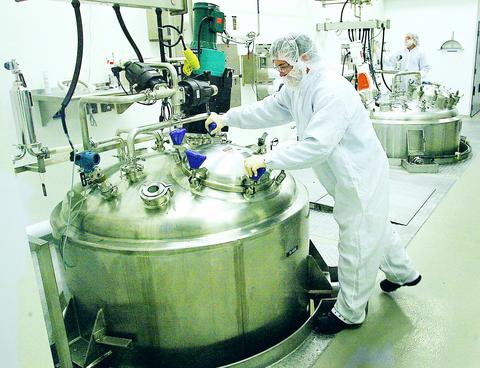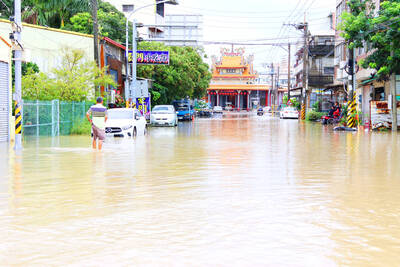On a quiet 14-hectare campus here, inside a series of large stainless steel vats that look more like they belong in a brewery than a lab, Abbott Laboratories is making what the North Chicago drug maker hopes will be the next huge-selling rheumatoid arthritis drug.
The drug, Humira, approved last week by regulators, was discovered, developed and manufactured at Abbott's Bioresearch Center here on a hilltop overlooking the UMass Medical Center and parts of downtown, and it has the potential to become the biggest-selling drug ever produced by the state's biotechnology industry.

PHOTO: NY TIMES
If it reaches anywhere near that potential, it will also be a major boon for Worcester. The city has long pinned its hopes on biotechnology as a way to offset its declining industrial base, but its nearly 20-year effort has yielded only modest results. Although the industry is growing, it remains small at 36 companies, 2,000 employees and US$200 million in revenues.
But Humira holds the promise of fueling the city's economic growth, and overhauling its image as a fading industrial town and a second-fiddle biotech player to the more thriving Cambridge hub. Abbott has already invested heavily in its Worcester operations, growing from about 330 people two years ago to more than 600 by year's end. It broke ground last month on a 5800m2 expansion that will cost US$50 million and increase the center's manufacturing capacity by 50 percent when the project is completed in late 2004.
`Liquid gold'
"This drug has been called liquid gold," said Kevin O'Sullivan, vice president of development at Massachusetts Biomedical Initiatives, a Worcester economic development organization. "It could provide a huge economic and psychological lift for the region, especially now when the economic climate is so uncertain. We have to work very, very hard here. We're not Boston, and we're not Kendall Square. We need successes like Abbott to breed future success."
Humira's introduction is also arguably the most important commercial launch in Abbott's 115-year history. It has the potential to be the company's most lucrative drug, generating more than a billion dollars in annual sales within the next three to four years and perhaps, one day, even reaching US$2 billion a year. If the drug delivers on its promise, it could transform what has long been considered a sleepy Midwestern firm into a major player in the pharmaceutical industry, putting to rest doubts raised among investors in recent years by a series of regulatory troubles and setbacks.
"Abbott has not been known in recent years as a pharmaceutical powerhouse," said Bruce Cranna, an analyst with Leerink Swann & Co in Boston. "Its drug business has been sluggish. It has an aging portfolio. But in Humira, you have a drug that has the potential to single-handedly rejuvenate its business."
But the competition for the US$3 billion rheumatoid arthritis market in the US promises to be fierce. The chief rivals, Enbrel and Remicade, are both huge-selling drugs considered highly effective in treating the debilitating autoimmune disease, easing the pain, swelling and stiffness in patients' joints that often strikes in their 20s or 30s and gradually robs them of their ability to walk, climb stairs and perform other rudimentary tasks.
US$10bn competitor
Amgen, the world's largest biotech company, paid US$10 billion last year to buy Seattle's Immunex to add the huge-selling Enbrel to its product portfolio. It markets the drug in partnership with Wyeth, another major drug maker. The other market leader, Remicade, is marketed by New Jersey drug giant Johnson & Johnson. With billions at stake, analysts said, none of the companies are going to give up market share without a fight.
"The size of the opportunity is not lost on them either," said Bruce Jacobs, an analyst with Deutsche Banc Alex. Brown in Boston. "The competition will be very intense."
Worcester's hopes rest not only on Abbott's ability to turn Humira's promise into reality but also on the company's willingness to use success to grow its Bioresearch Center. As the heart of Abbott's drug discovery and development efforts based on biological and genomic research, company officials said, the operations are critical to the future of the company's drug business.
After the merger, Abbott spent US$37 million to expand the Worcester site. The current expansion will bring the total to nearly US$90 million.
The center's researchers are investigating new ways to treat autoimmune disease, cancer and transplant-related immune complications. Besides Humira, the company plans to manufacture other protein-based drugs here. But in 2006, when construction of a plant in Puerto Rico is complete, some of the manufacturing of Humira will shift away from Worcester. Even so, O'Sullivan said, the plant will continue to provide at least 300 manufacturing jobs, and that is an important step forward for the city and state.
"The manufacturing side of the equation is paramount," O'Sullivan said. "Because those are jobs for high school and community college graduates. And that is extremely important."
Researchers embarked on the project in 1986 that eventually led to Humira's discovery. At the time, biotech firms were investing millions in the study of proteins known as monoclonal antibodies. Part of the body's natural immune response, the antibodies were hailed as biological "guided missiles" for their ability to seek out and destroy specific disease-causing cells. Scientists at Abbott's Worcester facility, then part of BASF, began experimenting with a monoclonal antibody derived from mice they believed might be a potential cancer drug.
DNA and the FDA
Meanwhile, other scientists experimented with ways of combining human and mouse elements, creating hybrids known as either chimeric or humanized antibodies depending on their ratios of human-to-mouse DNA sequences. Their efforts managed to rescue monoclonal antibodies from the recesses of the lab, and in 1994, ReoPro, a monoclonal antibody used in cardiovascular disease, was approved by the FDA. In 1997, Rituxan, the first monoclonal antibody to treat cancer, was approved.
Humira, however, is the first fully human monoclonal antibody to win FDA approval. The Worcester group succeeded in 1995 in creating a fully human antibody that like the mouse-derived version, bound to a protein known as tumor necrosis factor, or TNF, which is believed to play a role in numerous conditions, including arthritis, a gastrointestinal disorder known as Crohn's disease and a chronic skin condition known as psoriasis. Within two years of its discovery, Humira entered human clinical trials. And in 2001, the year Abbott bought BASF, the drug was completing the final phase of testing.
A crucial step
The BASF acquisition was critical to Abbott's ability to turn around its pharmaceutical business. The company, which logged US$16 billion in sales in 2001, sells an array of health care products, including hospital supplies, drugs, medical devices and diagnostics tests. But its pharmaceutical business lagged far behind the industry's top players, such as Pfizer, Merck and Eli Lilly.
The acquisition gave Abbott a pipeline of promising drugs, chief among them Humira. It also increased its revenues from drug sales to US$9 billion in 2001, edging Abbott into the ranks of the industry's top 10 players.
"The strategy we've set for the pharmaceutical business is to consistently develop breakthrough drugs to meet unmet medical needs," said Dr. Jeffrey M. Leiden, the head of Abbott's pharmaceutical division. "We've told the company that we are going to invest in the science. You have to build the cycle. We invest in the science to get growth and use that growth to reinvest in the company. Humira is an example of that."
Analysts predict that the investment in marketing and the ongoing clinical testing of Humira as a potential treatment for Crohn's, psoriasis and other forms of arthritis will cost more this year than the US$150 million to US$170 million they estimate the drug will generate in its first year of sales. But with the company's ability to turn around its drug business resting largely on Humira's success, analysts said, the investment is critical.
"It's a bet-the-company scenario," said Ted Huber, an analyst with Banc of America Securities. "If Humira is a success, it's a big boost for Abbott's science and its pharmaceutical business. If the drug flops, it puts Abbott in a difficult spot. They have a pipeline of other drugs that are important to the company's growth. They need Humira to support the development of those drugs. And to become a major player, they have to be more than a one-drug success story."

WAITING GAME: The US has so far only offered a ‘best rate tariff,’ which officials assume is about 15 percent, the same as Japan, a person familiar with the matter said Taiwan and the US have completed “technical consultations” regarding tariffs and a finalized rate is expected to be released soon, Executive Yuan spokeswoman Michelle Lee (李慧芝) told a news conference yesterday, as a 90-day pause on US President Donald Trump’s “reciprocal” tariffs is set to expire today. The two countries have reached a “certain degree of consensus” on issues such as tariffs, nontariff trade barriers, trade facilitation, supply chain resilience and economic security, Lee said. They also discussed opportunities for cooperation, investment and procurement, she said. A joint statement is still being negotiated and would be released once the US government has made

NEW GEAR: On top of the new Tien Kung IV air defense missiles, the military is expected to place orders for a new combat vehicle next year for delivery in 2028 Mass production of Tien Kung IV (Sky Bow IV) missiles is expected to start next year, with plans to order 122 pods, the Ministry of National Defense’s (MND) latest list of regulated military material showed. The document said that the armed forces would obtain 46 pods of the air defense missiles next year and 76 pods the year after that. The Tien Kung IV is designed to intercept cruise missiles and ballistic missiles to an altitude of 70km, compared with the 60km maximum altitude achieved by the Missile Segment Enhancement variant of PAC-3 systems. A defense source said yesterday that the number of

Taiwanese exports to the US are to be subject to a 20 percent tariff starting on Thursday next week, according to an executive order signed by US President Donald Trump yesterday. The 20 percent levy was the same as the tariffs imposed on Vietnam, Sri Lanka and Bangladesh by Trump. It was higher than the tariffs imposed on Japan, South Korea and the EU (15 percent), as well as those on the Philippines (19 percent). A Taiwan official with knowledge of the matter said it is a "phased" tariff rate, and negotiations would continue. "Once negotiations conclude, Taiwan will obtain a better

FLOOD RECOVERY: “Post-Typhoon Danas reconstruction special act” is expected to be approved on Thursday, the premier said, adding the flood control in affected areas would be prioritized About 200cm of rainfall fell in parts of southern Taiwan from Monday last week to 9am yesterday, the Central Weather Administration (CWA) said. Kaohsiung’s Taoyuan District (桃源) saw total rainfall of 2,205mm, while Pingtung County’s Sandimen Township (三地門) had 2,060.5mm and Tainan’s Nanhua District (南化) 1,833mm, according to CWA data. Meanwhile, Alishan (阿里山) in Chiayi County saw 1,688mm of accumulated rain and Yunlin County’s Caoling (草嶺) had 1,025mm. The Pingtung County Government said that 831 local residents have been pre-emptively evacuated from mountainous areas. A total of 576 are staying with relatives in low-lying areas, while the other 255 are in shelters. CWA forecaster